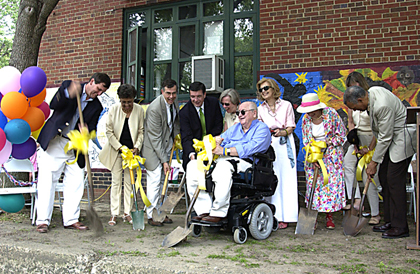
| NEWS |
| |
| FEATURES |
| ENTERTAINMENT |
| COLUMNS |
| CONTACT US |
| HOW TO SUBMIT |
| BACK ISSUES |

caption:
|
Arts Council Breaks New Ground
Matthew Hersh
"Dig It" was the theme, and dig they did as the Arts Council of Princeton hosted a symbolic groundbreaking Sunday for an expanded facility, the Paul Robeson Center for the Arts, at the corner of Paul Robeson Place and Witherspoon Street.
An entire cross section of the community was on-hand to witness an event that some feared would never happen at the current site: the first steps toward building a 16,740-square-foot facility. Once completed, the entire structure will add 8,040 square feet to the current building. Besides allowing the Arts Council to include expanded programming, the new addition will transform that corner of Princeton, with the new Princeton Public Library standing on the other side of the intersection, into a notable cultural center.
"Today, for me, marks the beginning of the future for the Arts Council of Princeton," said Jeff Nathanson, who recently assumed the post of executive director, succeeding Anne Reeves. "But we can't go into the future without acknowledging that we have a really amazing history," he added, speaking to a gathering that included Mercer County Executive Brian Hughes, U.S. Rep. Rush Holt (D-12), Princeton University President Shirley Tilghman, architect Michael Graves, Paul Robeson Jr., Township Mayor Phyllis Marchand, Township Committeeman Lance Liverman, and Borough Council President Mildred Trotman.
The history of the building and its location in the John-Witherspoon neighborhood was what compelled Arts Council officials to mount the effort to keep the expansion on-site. But when residents of the surrounding neighborhood voiced concern that an expanded facility would begin a trend toward development throughout the neighborhood, members of the Arts Council board of trustees considered entirely relocating the institution.
Any question of the Arts Council leaving, however, was answered when its expansion plans were approved by the Regional Planning Board of Princeton in June 2004, allowing the organization, which first rented 102 Witherspoon Street from the Borough in 1982, and then purchased it outright in 1996, to stay in place.
That decision, according to Mr. Robeson ‹ whose famous multi-talented father, a noted actor, singer, and athlete, born on John Street, and will be the new building's namesake ‹ was appropriate for more reasons than one.
Originally built as a Work Progress Administration project that served as the so-called "Black Y" for several years, the Arts Council building was among the stops on a civil rights walk two years ago. "What this institution already represented, in terms of the connection to the community based on the merits of its programming and its future plans Š speaks volumes, regardless of what people on any side [thought]," he said in an interview, adding, "I think the actual existence of the center, and its choice of Paul Robeson as a symbolic legacy, speaks for itself."
In his public remarks Sunday, Mr. Robeson praised the Arts Council for its pursuit of an expanded building and the $7.5 million capital campaign underway to finance the project. The Arts Council, which has reached about half of its goal, is still about $1 million shy of the point where any real construction can begin, said Peter Bienstock, the Arts Council board member who heads up the capital campaign. Sunday's presentation also paid tribute to Dean Mathey, whose estate has provided significant funding to the project.
Mr. Robeson, who acknowledged that the establishment of an expanded community center was an "enormously difficult task," emphasized the importance of keeping the institution where it has been for more than two decades.
"It's the right context, the right place, the right people, the right reason, and the right conjunction of names," he said.
Mr. Robeson also lauded architect Michael Graves, of the Princeton-based Michael Graves & Associates, as "the right person to put his full spirit into the project." Mr. Graves donated the design to the Arts Council. In an interview prior to the groundbreaking, Mr. Graves said he was eager to move forward.
"It's going to be wonderful to get going on this, it's been so long," he said, and then restated the importance of keeping the facility where it is. "If I had all the sites in Princeton to choose from, this would be it." Mr. Graves said location was key because of the aim for the Arts Council to remain accessible to pedestrians. "If it moved, people would have to get into their cars and go to a drawing class for 10-year-olds. It doesn't make any sense at all."
